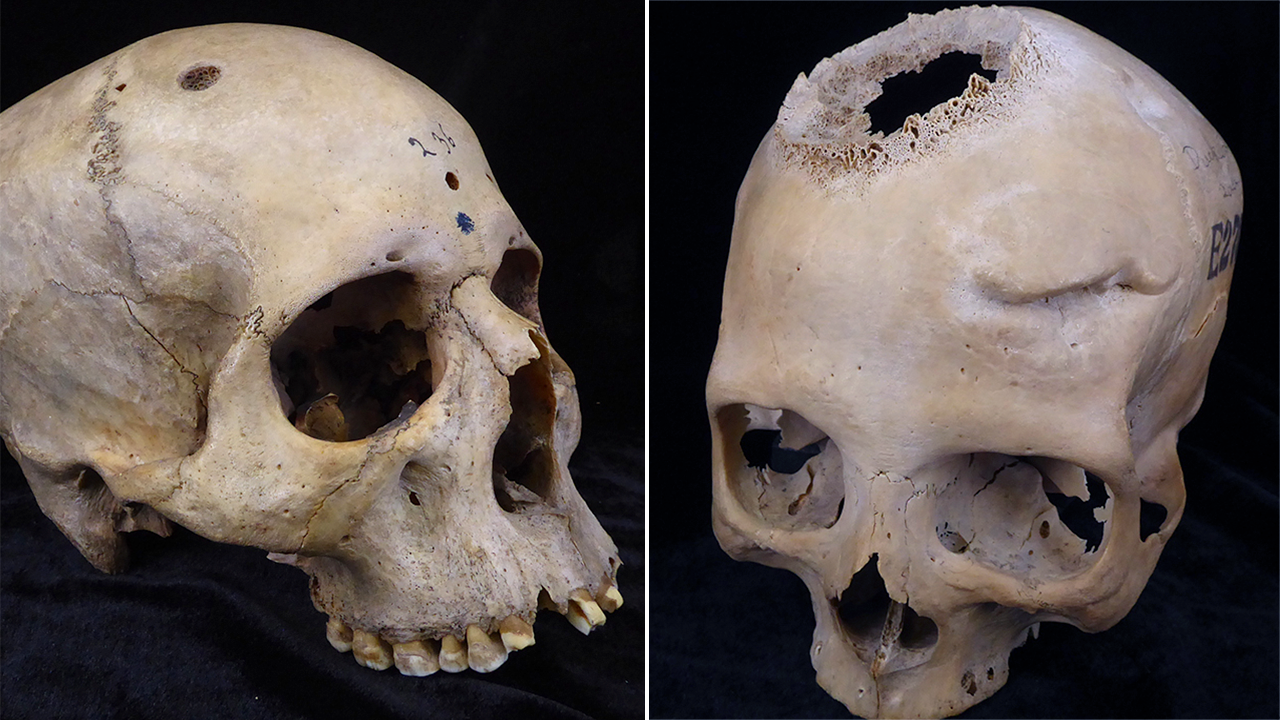Lesions found in ancient skulls suggest that cancer could have been a medical issue long before our time.
Ancient Egyptian skulls studied at the Duckworth Laboratory Collection at the University of Cambridge in the U.K. have shown signs of varying lesions, some believed to be left by malignant tumors.
The case report, published in the journal Frontiers in Medicine, found that a skull labeled E270, which belonged to a woman in her 50s, had healed cranial injuries made potentially by a sharp object.
ARCHAEOLOGISTS EXCAVATE HAUNTING ‘CITY OF THE DEAD’ PACKED WITH HUNDREDS OF TOMBS
The evidence indicates that the woman survived, thanks to “some kind of treatment and degree of post-traumatic care,” the researchers wrote.
Skull 236, belonging to a male in his 30s, was shown to have cut marks on the bone surface that suggest a tumor had been removed.
Skull E270 is shown at the base of a microscope. The skull had healed cranial injuries potentially caused by a sharp object. (Tatiana Tondini, Albert Isidro, Edgard Camarós, 2024)
While these findings indicate “medical surgical exploration,” the researchers were unable to identify the timing of the cutting – before or after death.
“Applying scientific methodologies to archeology allows us to make new discoveries about the past.”
These surgical procedures could have been practiced during the Middle and Upper Paleolithic and Neolithic periods, the researchers concluded.
“In this context, it becomes clear that caring for others, including wound care, is a key behavior among humans that has also been observed in non-human primates,” they wrote.
ARCHAEOLOGISTS SURPRISED BY ‘INTRIGUING’ ART DRAWN BY CHRISTIAN PILGRIMS 1,500 YEARS AGO
First study author Tatiana Tondini, a researcher at the University of Tübingen in Germany, discussed the results with Fox News Digital, noting that the most “remarkable finding” was the discovery of cut marks near “two secondary cancer lesions” on skull 236.
“They have been confirmed not to be taphonomic (environmental) damages, and there are two explanations for them,” she said.
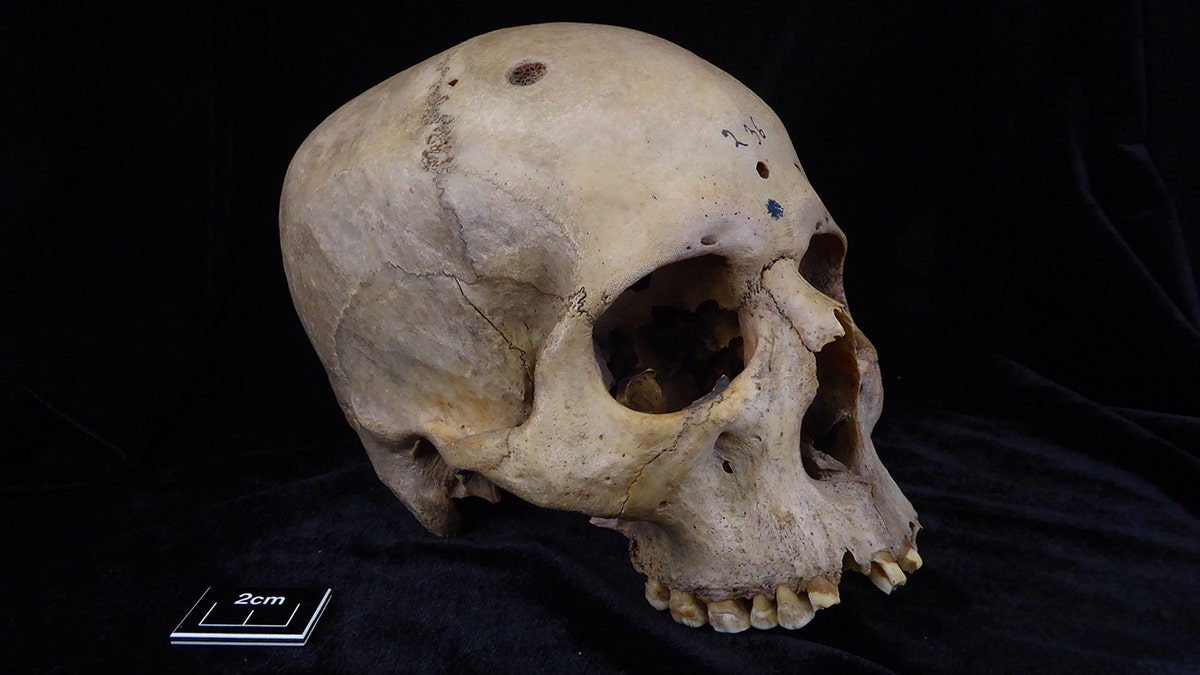
Skull 236, pictured here, was shown to have two “secondary cancer lesions.” (Tatiana Tondini, Albert Isidro, Edgard Camarós, 2024)
The first possible explanation is that the ancient Egyptians attempted a surgical removal of the secondary tumors, “which would make it the first recorded cancer surgical operation in history, but we cannot confirm that,” Tondini said.
The second possibility is that the ancient Egyptians made those cut marks while examining the man after he passed away.
“Caring for others, including wound care, is a key behavior among humans.”
“This would also be remarkable, as it means that the ancient Egyptians were studying cancer,” the researcher said.
Another important discovery, according to Tondini, was the successful treatment of skull E270, which had traces of a lesion left by a sharp object like a sword or hatchet.

Skull E270, pictured here, had traces of a lesion left by a sharp object like a sword or hatchet. (Tatiana Tondini, Albert Isidro, Edgard Camarós, 2024)
“It is very unlikely that the individual would have made it without proper treatment,” she said.
“We can see that the individual survived, as the fracture has clear signs of healing, which means ancient Egyptians were able to treat severe cranial fractures.”
STATUE OF GREEK GOD UNCOVERED BY ARCHAEOLOGISTS DURING EXCAVATION OF ANCIENT ROMAN SEWER IN BULGARIA
An accident or act of domestic violence was the most likely cause of the woman’s head injury, according to Tondini, although the depth of the wound and the sign of brutality could point to a battle wound.
“If that is the case, we should reconsider the role of women in Ancient Egypt,” she said. “It is known that women had more rights in Ancient Egypt compared to Rome and Greece, but warfare duties have always been associated with men.”
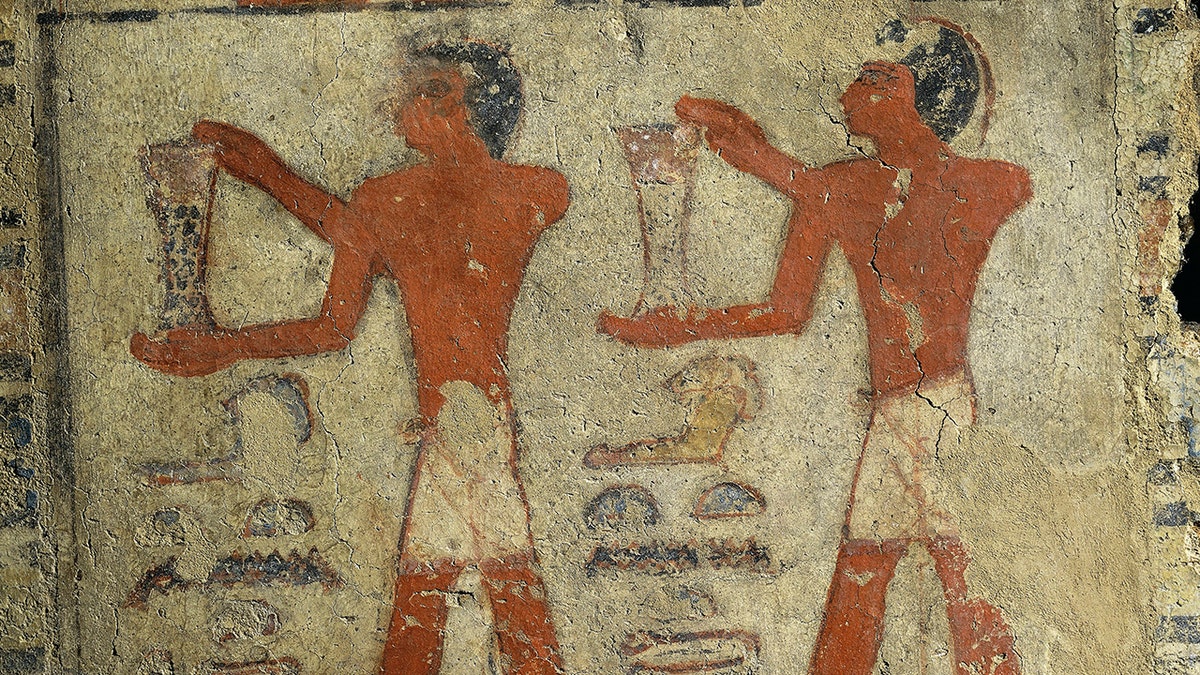
A fragment of wall painting depicts the transport of ointments, found in the tomb of Metchetchi at Saqqara in Egypt. (DEA/G. DAGLI ORTI/De Agostini via Getty Images)
As the skulls were “very old” and “very fragile,” Tondini said it was difficult to assess the damage with the naked eye.
“But using a powerful microscope, it was possible to characterize most lesions,” she said. “For some more complex ones, the micro-CT scan allowed us to analyze the internal structure of a lesion and determine its cause.”
‘Cancer culture’
Based on the findings from skull 236, the researchers believe that cancer is not only a modern disease caused by unhealthy lifestyles and exposure to carcinogens, but that it was also present in ancient populations — though at lower rates, according to Tondini.
NEW JERSEY WOMAN SINGS TAYLOR SWIFT HITS WHILE AWAKE DURING BRAIN SURGERY: ‘ERAS TOUR’ IN THE O.R.
Tondini admitted that she and her fellow researchers did not expect these findings before investigating these two “very rare” pieces of history.
“I remember I was analyzing skull 236 with the microscope to characterize its lesions,” she told Fox News Digital. “When I got to the first lesion that had those cut marks, I initially was a bit unsure of what I was looking at.”

A lesion inside skull 236 shows cut marks identified under the microscope. (Tatiana Tondini, Albert Isidro, Edgard Camarós, 2024)
“I asked my colleague, Dr. Camaros, who was also very surprised about the discovery,” she continued. “We characterized the cut marks and confirmed they were manmade and occurred before or immediately after the death of the individual.”
Within a few minutes, Tondini said, the laboratory was “filled with other researchers, technicians and professors, who were all around the microscope looking at the lesions and could not believe their eyes.”
Neurosurgeon’s take
Dr. Paul Saphier, M.D., a neurosurgeon and founder of Coaxial Neurosurgical Specialists in New Jersey, commented that while this new research is interesting, there has been similar evidence of neurosurgical procedures dating back to the Mesolithic period, around 6000 B.C.
“These early surgeries [known as trepanning] were usually small holes in the skull with limited surgical extent,” Saphier, who was not involved in the skull research at hand, told Fox News Digital.
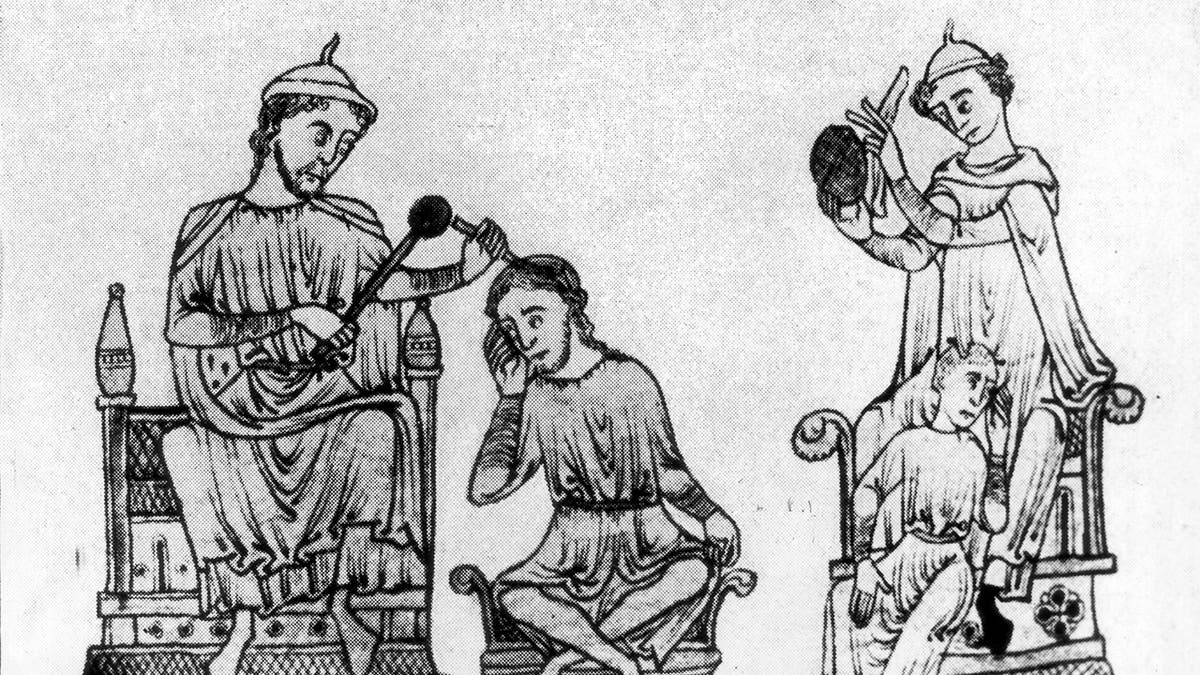
A medieval surgeon performs a “trepanning” operation on a patient’s skull, circa 1350. (Hulton Archive/Getty Images)
“Clearly, our ability to perform complex neurosurgical procedures was limited by technology, mostly radiographic (CT/MRI imaging) and direct surgical visualization.”
CLICK HERE TO SIGN UP FOR OUR HEALTH NEWSLETTER
The neurosurgeon added, “With these advances, as well as anesthesia and critical care medicine, we have been able to tackle more sophisticated cases, large in scope and extent.”
For more Health articles, visit www.foxnews.com/health
In an “ironic twist,” he said, recently there’s been a “tremendous reversal toward a more minimally invasive approach” in cranial neurosurgery.
“This has been heralded by newer tech and an outspoken group of advanced cranial neurosurgeons championing these advances, of which I am proud to be a member of,” Saphier added.
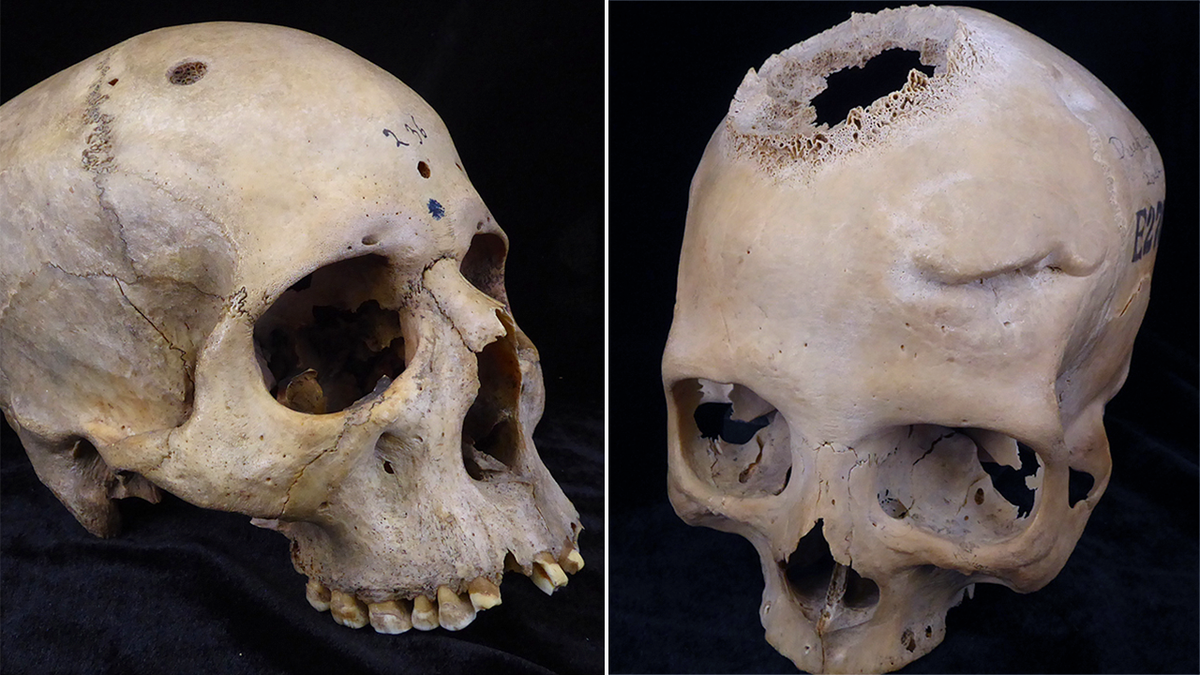
Skull 236, at left, and skull E270, right, revealed interesting findings about ancient medicine. (Tatiana Tondini, Albert Isidro, Edgard Camarós, 2024)
“So ironically, what is old may … actually be new again.”
Tondini said she hopes the study findings will inspire more research on “cancer cases in antiquities using non-destructive techniques.”
CLICK HERE TO GET THE FOX NEWS APP
“For other researchers and the public, applying scientific methodologies to archeology allows us to make new discoveries about the past,” she said.
